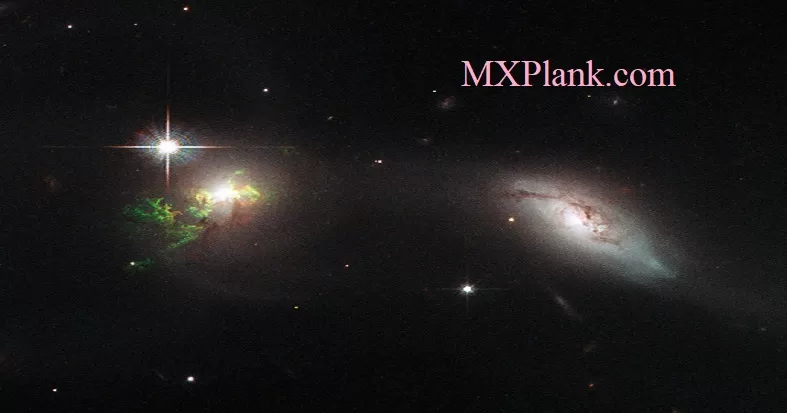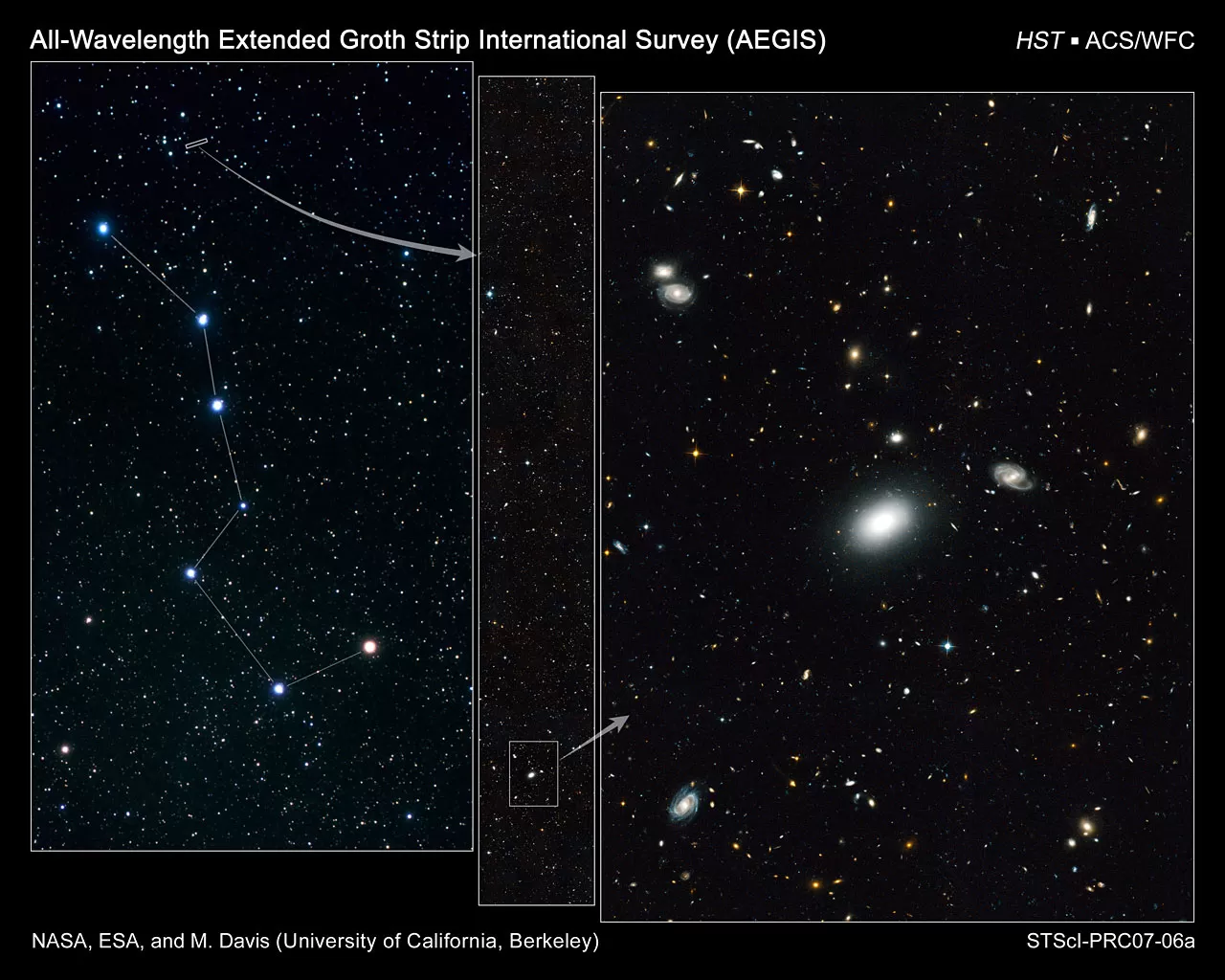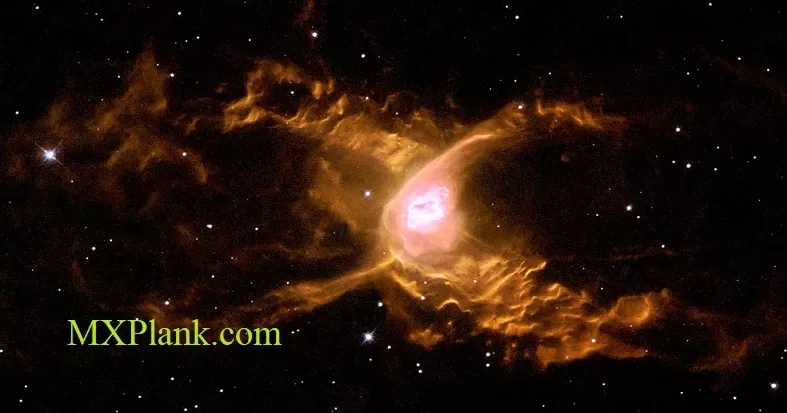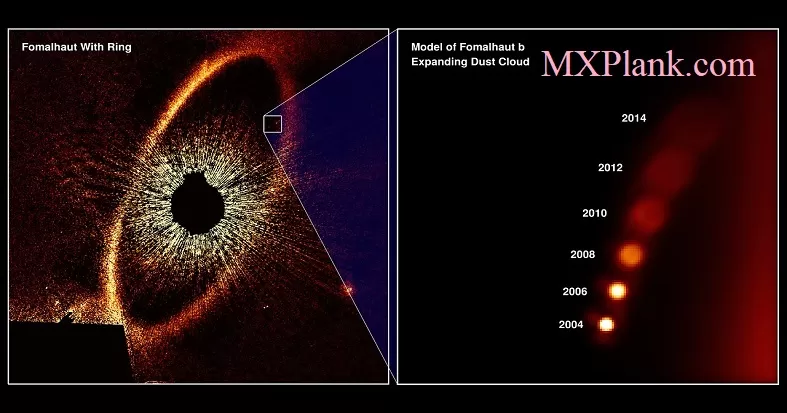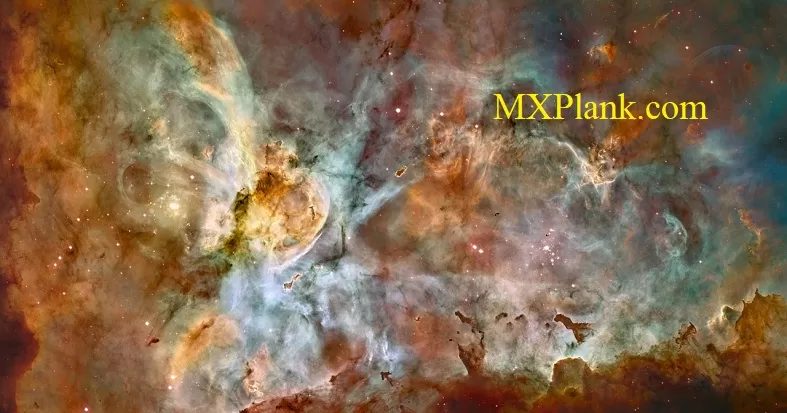FOMALHAUT B IN 2012

Fomalhaut b, formally named Dagon, is a directly imaged extrasolar object and candidate planet orbiting the A-type main-sequence star Fomalhaut, approximately 25 light-years away in the constellation of Piscis Austrinus. The object was initially announced in 2008 and confirmed as real in 2012 from images taken with the Advanced Camera for Surveys (ACS) on the Hubble Space Telescope and, according to calculations reported in January 2013, has a 1,700-year, highly elliptical orbit. It has a periastron of 7.4 billion km (~50 AU) and an apastron of about 44 billion km (~300 AU). As of May 25, 2013 it is 110 AU from its parent star.
The true nature of Fomalhaut b is the subject of significant debate. Fomalhaut b was initially identified as one of the first exoplanets to be directly imaged: its detection was attributed to reflected light from circumplanetary material (e.g. a dust ring) and thermal emission from a jovian planet atmosphere. Fomalhaut b has subsequently been described as a low-mass planet whose surrounding dust cloud is entirely responsible for its detection or, most recently, debris from a collision of asteroids instead. On May 7, 2020, the NASA exoplanet archive officially removed Fomalhaut b from its list of exoplanet candidates (confirmed or not).
The object was one of those selected by the International Astronomical Union as part of their public process for giving proper names to exoplanets. The process involved public nomination and voting for the new name. In December 2015, the IAU announced the winning name was Dagon. The name Dagon was proposed by Dr. Todd Vaccaro and forwarded by the St. Cloud State University Planetarium to the IAU for consideration. Dagon was a Semitic deity, often represented as half-man, half-fish.
The nature of Fomalhaut b is likely a dust cloud. On one hand, Fomalhaut b could be a planet less than twice Jupiter's mass that is either enshrouded in a spherical cloud of dust from ongoing planetesimal collisions

Fomalhaut b and three companions around HR 8799, whose discovery was announced simultaneously, were described as the first directly imaged extrasolar planets (among earlier claims such as e.g. 2M1207 b, GQ Lup b, DH Tau b, AB Pic b, CHXR 73 b, UScoCTIO 108 b, CT Cha b, 1RXS 1609 b) in that their emission was thought to originate at least in part from a planetary atmosphere. However, subsequent studies from the Spitzer Space Telescope and a reanalysis of the original HST data instead suggest that Fomalhaut b's light is scattered starlight, not planet thermal emission.
The existence of a massive planet orbiting Fomalhaut was first inferred from Hubble observations published in 2005 that resolved the structure of Fomalhaut's massive, cold debris disk (or dust belt/ring). The belt is not centered on the star, and has a sharper inner boundary than would normally be expected. A massive planet on a wide orbit but located interior to this debris ring could clear out parent bodies and dust in its vicinity, leaving the ring appearing to have a sharp inner edge and making it appear offset from the star.
In May 2008, Paul Kalas, James Graham and their collaborators identified Fomalhaut b from Hubble/ACS images taken in 2004 and 2006 at visible wavelengths (i.e. 0.6 and 0.8 µm). NASA released the composite discovery photograph on November 13, 2008, coinciding with the publication of Kalas et al. discovery in Science.
Kalas remarked, "It's a profound and overwhelming experience to lay eyes on a planet never before seen. I nearly had a heart attack at the end of May when I confirmed that Fomalhaut b orbits its parent star." In the image, the bright outer oval band is the dust ring, while the features inside of this band represent noise from scattered starlight.
In the discovery paper, Kalas and collaborators suggested that Fomalhaut b's emission originates from two sources: from circumplanetary dust scattering starlight and from planet thermal emission. Here, the former explains most of the 0.6 µm brightness and planet thermal emission contributes to much of the 0.8 µm brightness. Their non-detections with ground-based infrared data suggested that Fomalhaut b had to be less massive than about 3 Jupiter masses.
However, Fomalhaut b should be detectable in space-based infrared data if its mass is between 1-3 Jupiter masses. But sensitive infrared Spitzer Space Telescope observations failed to detect Fomalhaut b, implying that Fomalhaut b has less than 1 Jupiter mass. Furthermore, although the planet was thought to be a plausible explanation for Fomalhaut's eccentric debris ring, measurements in the Kalas et al. paper hinted that it was moving too fast (i.e. not apsidally aligned) for this explanation to work. Finally, researchers analyzing September-October 2011 Atacama Large Millimeter Array (ALMA) data for Fomalhaut's debris ring suggested an alternate hypothesis: that the ring could be shaped by much smaller, shepherding planets, neither of which needed to be Fomalhaut b.These results invoked skepticism about Fomalhaut b's status as an extrasolar planet.
On October 24, 2012, a team led by Thayne Currie at the University of Toronto announced the first independent recovery of Fomalhaut b and revived the claim that Fomalhaut b identifies a planet. They reanalyzed the original Hubble data using new, more powerful algorithms for separating planet light from starlight and confirmed that Fomalhaut b does exist. They also provided a new detection of Fomalhaut b at 0.4 µm. They modeled the optical detections and infrared upper limits for Fomalhaut b, showing that Fomalhaut b's emission can be completely explained by starlight scattered by small dust and arguing that this dust surrounds an unseen planetary-mass object. Thus, they consider Fomalhaut b to plausibly be a "planet identified from direct imaging" even if Fomalhaut b is not, strictly speaking, a directly imaged planet insofar as the light does not come from a planetary atmosphere.
A second paper made public a day later and led by Raphael Galicher and Christian Marois at the Herzberg Institute of Astrophysics also independently recovered Fomalhaut b and confirmed the new 0.4 µm detection, claiming the spectral energy distribution (SED) of Fomalhaut b cannot be explained as due to direct or scattered radiation from a massive planet. They considered two models to explain the SED: (1) a large circumplanetary disk around a massive, but unseen, planet and (2) the aftermath of a collision during the past 100 years of two Kuiper belt objects of radii about 50 km.
Subsequent Hubble data obtained in 2010 and 2012 with the STIS instrument by Paul Kalas and collaborators again recovered Fomalhaut b. However, analysis of Fomalhaut b's astrometry showed that the object has a high eccentricity (e = 0.8), its orbit (projected on the sky) crosses the plane of Fomalhaut's debris ring, and thus it is unlikely to be the object sculpting the debris ring's sharp inner edge. Fomalhaut b's high eccentricity may be evidence for a significant dynamical interaction with a hitherto unseen planet at a smaller orbital separation.
Analyses of additional STIS data obtained in 2013 and 2014 argue that Fomalhaut b is fading and expanding in size, a behavior that may support the interpretation of Fomalhaut b as a collision between two asteroid-sized objects.
The revival of the claim that Fomalhaut b is (possibly) a planet after it had been discounted led some to nickname the object a "zombie planet", although this is a non-technical term used in press material and does not appear in any peer-reviewed manuscript.
Based on the (now disproven) assumption that Formalhaut b was a gaseous planet, the existence of additional planets closer to the star has been postulated. Fomalhaut b is orbiting its host star at a wide separation, where forming massive planets would be difficult. To explain its current location, Fomalhaut b would have had to be dynamically scattered by a more massive, unseen body located at smaller separations. Several ground-based observations have searched for this hypothetical Fomalhaut "c" but have yet to find it. At very small, Solar-System-like scales any additional companions must have a mass less than thirteen times the mass of Jupiter. At slightly wider scales comparable to the locations of the planets around HR 8799, any additional planets of Formalhaut must have masses below about 2 to 7 Jupiter masses. A gaseous planet in an orbit like Formalhaut b could have formed in situ if it coalesced from small pebble-sized objects that rapidly formed into a protoplanetary core which in turn accreted a gaseous envelope.
The true nature of Fomalhaut b is the subject of significant debate. Fomalhaut b was initially identified as one of the first exoplanets to be directly imaged: its detection was attributed to reflected light from circumplanetary material (e.g. a dust ring) and thermal emission from a jovian planet atmosphere. Fomalhaut b has subsequently been described as a low-mass planet whose surrounding dust cloud is entirely responsible for its detection or, most recently, debris from a collision of asteroids instead. On May 7, 2020, the NASA exoplanet archive officially removed Fomalhaut b from its list of exoplanet candidates (confirmed or not).
The object was one of those selected by the International Astronomical Union as part of their public process for giving proper names to exoplanets. The process involved public nomination and voting for the new name. In December 2015, the IAU announced the winning name was Dagon. The name Dagon was proposed by Dr. Todd Vaccaro and forwarded by the St. Cloud State University Planetarium to the IAU for consideration. Dagon was a Semitic deity, often represented as half-man, half-fish.
The nature of Fomalhaut b is likely a dust cloud. On one hand, Fomalhaut b could be a planet less than twice Jupiter's mass that is either enshrouded in a spherical cloud of dust from ongoing planetesimal collisions

Fomalhaut B in 2012
Fomalhaut b and three companions around HR 8799, whose discovery was announced simultaneously, were described as the first directly imaged extrasolar planets (among earlier claims such as e.g. 2M1207 b, GQ Lup b, DH Tau b, AB Pic b, CHXR 73 b, UScoCTIO 108 b, CT Cha b, 1RXS 1609 b) in that their emission was thought to originate at least in part from a planetary atmosphere. However, subsequent studies from the Spitzer Space Telescope and a reanalysis of the original HST data instead suggest that Fomalhaut b's light is scattered starlight, not planet thermal emission.
The existence of a massive planet orbiting Fomalhaut was first inferred from Hubble observations published in 2005 that resolved the structure of Fomalhaut's massive, cold debris disk (or dust belt/ring). The belt is not centered on the star, and has a sharper inner boundary than would normally be expected. A massive planet on a wide orbit but located interior to this debris ring could clear out parent bodies and dust in its vicinity, leaving the ring appearing to have a sharp inner edge and making it appear offset from the star.
In May 2008, Paul Kalas, James Graham and their collaborators identified Fomalhaut b from Hubble/ACS images taken in 2004 and 2006 at visible wavelengths (i.e. 0.6 and 0.8 µm). NASA released the composite discovery photograph on November 13, 2008, coinciding with the publication of Kalas et al. discovery in Science.
Kalas remarked, "It's a profound and overwhelming experience to lay eyes on a planet never before seen. I nearly had a heart attack at the end of May when I confirmed that Fomalhaut b orbits its parent star." In the image, the bright outer oval band is the dust ring, while the features inside of this band represent noise from scattered starlight.
In the discovery paper, Kalas and collaborators suggested that Fomalhaut b's emission originates from two sources: from circumplanetary dust scattering starlight and from planet thermal emission. Here, the former explains most of the 0.6 µm brightness and planet thermal emission contributes to much of the 0.8 µm brightness. Their non-detections with ground-based infrared data suggested that Fomalhaut b had to be less massive than about 3 Jupiter masses.
However, Fomalhaut b should be detectable in space-based infrared data if its mass is between 1-3 Jupiter masses. But sensitive infrared Spitzer Space Telescope observations failed to detect Fomalhaut b, implying that Fomalhaut b has less than 1 Jupiter mass. Furthermore, although the planet was thought to be a plausible explanation for Fomalhaut's eccentric debris ring, measurements in the Kalas et al. paper hinted that it was moving too fast (i.e. not apsidally aligned) for this explanation to work. Finally, researchers analyzing September-October 2011 Atacama Large Millimeter Array (ALMA) data for Fomalhaut's debris ring suggested an alternate hypothesis: that the ring could be shaped by much smaller, shepherding planets, neither of which needed to be Fomalhaut b.These results invoked skepticism about Fomalhaut b's status as an extrasolar planet.
On October 24, 2012, a team led by Thayne Currie at the University of Toronto announced the first independent recovery of Fomalhaut b and revived the claim that Fomalhaut b identifies a planet. They reanalyzed the original Hubble data using new, more powerful algorithms for separating planet light from starlight and confirmed that Fomalhaut b does exist. They also provided a new detection of Fomalhaut b at 0.4 µm. They modeled the optical detections and infrared upper limits for Fomalhaut b, showing that Fomalhaut b's emission can be completely explained by starlight scattered by small dust and arguing that this dust surrounds an unseen planetary-mass object. Thus, they consider Fomalhaut b to plausibly be a "planet identified from direct imaging" even if Fomalhaut b is not, strictly speaking, a directly imaged planet insofar as the light does not come from a planetary atmosphere.
A second paper made public a day later and led by Raphael Galicher and Christian Marois at the Herzberg Institute of Astrophysics also independently recovered Fomalhaut b and confirmed the new 0.4 µm detection, claiming the spectral energy distribution (SED) of Fomalhaut b cannot be explained as due to direct or scattered radiation from a massive planet. They considered two models to explain the SED: (1) a large circumplanetary disk around a massive, but unseen, planet and (2) the aftermath of a collision during the past 100 years of two Kuiper belt objects of radii about 50 km.
Subsequent Hubble data obtained in 2010 and 2012 with the STIS instrument by Paul Kalas and collaborators again recovered Fomalhaut b. However, analysis of Fomalhaut b's astrometry showed that the object has a high eccentricity (e = 0.8), its orbit (projected on the sky) crosses the plane of Fomalhaut's debris ring, and thus it is unlikely to be the object sculpting the debris ring's sharp inner edge. Fomalhaut b's high eccentricity may be evidence for a significant dynamical interaction with a hitherto unseen planet at a smaller orbital separation.
Analyses of additional STIS data obtained in 2013 and 2014 argue that Fomalhaut b is fading and expanding in size, a behavior that may support the interpretation of Fomalhaut b as a collision between two asteroid-sized objects.
The revival of the claim that Fomalhaut b is (possibly) a planet after it had been discounted led some to nickname the object a "zombie planet", although this is a non-technical term used in press material and does not appear in any peer-reviewed manuscript.
Based on the (now disproven) assumption that Formalhaut b was a gaseous planet, the existence of additional planets closer to the star has been postulated. Fomalhaut b is orbiting its host star at a wide separation, where forming massive planets would be difficult. To explain its current location, Fomalhaut b would have had to be dynamically scattered by a more massive, unseen body located at smaller separations. Several ground-based observations have searched for this hypothetical Fomalhaut "c" but have yet to find it. At very small, Solar-System-like scales any additional companions must have a mass less than thirteen times the mass of Jupiter. At slightly wider scales comparable to the locations of the planets around HR 8799, any additional planets of Formalhaut must have masses below about 2 to 7 Jupiter masses. A gaseous planet in an orbit like Formalhaut b could have formed in situ if it coalesced from small pebble-sized objects that rapidly formed into a protoplanetary core which in turn accreted a gaseous envelope.
Credit:
NASA/ESA and The Hubble Heritage Team (STScI/AURA)
NASA/ESA and The Hubble Heritage Team (STScI/AURA)

